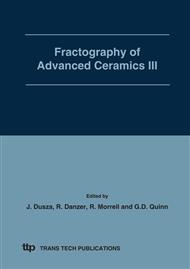p.201
p.209
p.216
p.223
p.231
p.237
p.244
p.252
p.260
Crack Growth Resistance of Carbide Reinforced Composite Ceramics Based on Alumina
Abstract:
The relationship of KR versus crack length c (R curve) for Al2O3-30wt.% Ti(C,N).and for comparison alumina ceramics has been examined. The R-curve has been evaluated using pronounced long-crack formed during the three point bending (3PB) of the double edge notched beam. A combination of in situ microscopic crack growth observation and mechanical testing enabled measurement of crack growth resistance curves. The special device consisting of light microscope coupled with CCD camera, was fitted to Zwick 1446 testing machine. These observations reveal the existence of flat R-curve for Al2O3-30wt.% Ti(CN) and increasing R-curve for pure alumina. A study of slow-crack-growth (SCG) in tested materials was carried. The load-relaxation technique was used for observation at slow-crack-growth. The crack length was evaluated by linear-elastic analysis from the compliance of single-edge-notched specimen in three-point bending test. Parameters of stable crack growth n and logA, work-of fracture (WOF), stress intensity factor at the moment of crack initiation KI0 and maximum values of stress intensity factor KImax were determined. Mechanism of grain bridging responsible for occurrence of R-curve was observed by SEM and TEM.
Info:
Periodical:
Pages:
231-236
Citation:
Online since:
March 2009
Authors:
Keywords:
Price:
Сopyright:
© 2009 Trans Tech Publications Ltd. All Rights Reserved
Share:
Citation:


